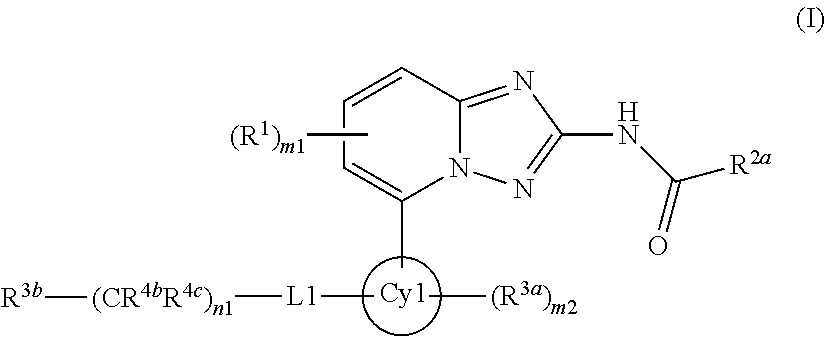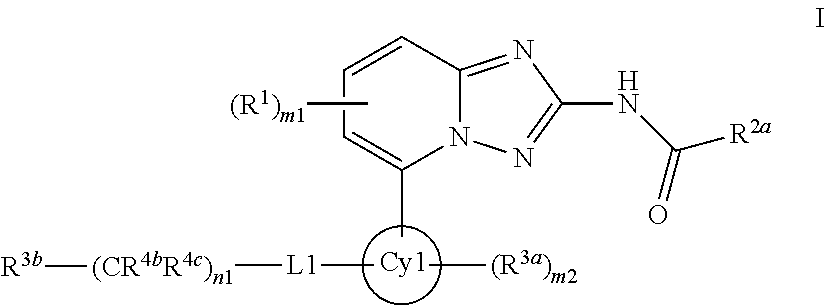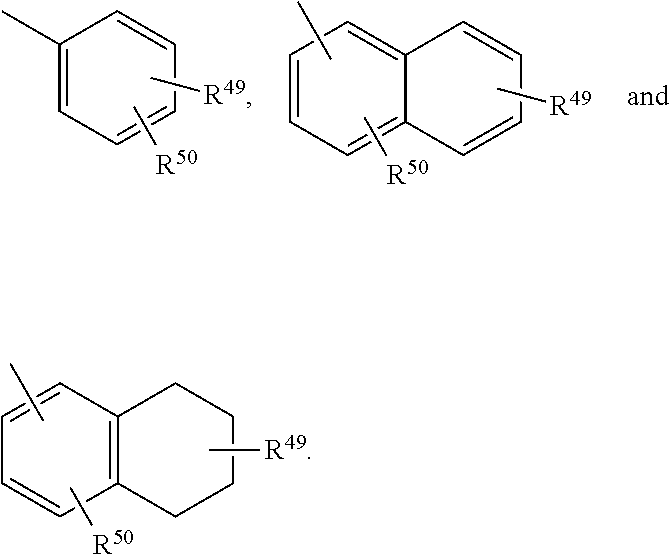Novel compounds useful for the treatment of degenerative and inflammatory diseases
a technology of degenerative and inflammatory diseases and compounds, applied in the direction of antinoxious agents, drug compositions, immunological disorders, etc., can solve the problems of limited cartilage tissue regeneration ability, pain and loss of mobility, cartilage degradation, etc., to prevent or treat any maladies, treat or alleviate maladies or symptoms
- Summary
- Abstract
- Description
- Claims
- Application Information
AI Technical Summary
Benefits of technology
Problems solved by technology
Method used
Image
Examples
example 1
In Vitro Assays
Example 1.1
JAK1 Inhibition Assay
[0803]Recombinant human JAK1 catalytic domain (amino acids 850-1154; catalog number 08-144) was purchased from Carna Biosciences. 10 ng of JAK1 was incubated with 12.5 μg polyGT substrate (Sigma catalog number P0275) in kinase reaction buffer (15 mM Tris-HCl pH 7.5, 1 mM DTT, 0.01% Tween-20, 10 mM MgCl2, 2 μM non-radioactive ATP, 0.25 μCi 33P-gamma-ATP (GE Healthcare, catalog number AH9968) final concentrations) with or without 5 μL containing test compound or vehicle (DMSO, 1% final concentration), in a total volume of 25 μL, in a polypropylene 96-well plate (Greiner, V-bottom). After 45 min at 30° C., reactions were stopped by adding of 25 μL / well of 150 mM phosphoric acid. All of the terminated kinase reaction was transferred to prewashed (75 mM phosphoric acid) 96 well filter plates (Perkin Elmer catalog number 6005177) using a cell harvester (Perkin Elmer). Plates were washed 6 times with 300 μL per well of a 75 mM phosphoric acid ...
example 1.2
JAK2 Inhibition Assay
[0810]Recombinant human JAK2 catalytic domain (amino acids 808-1132; catalog number PV4210) was purchased from Invitrogen. 0.025 mU of JAK2 was incubated with 2.5 μg polyGT substrate (Sigma catalog number P0275) in kinase reaction buffer (5 mM MOPS pH 7.5, 9 mM MgAc, 0.3 mM EDTA, 0.06% Brij and 0.6 mM DTT, 1 μM non-radioactive ATP, 0.25 μCi 33P-gamma-ATP (GE Healthcare, catalog number AH9968) final concentrations) with or without 5 μL containing test compound or vehicle (DMSO, 1% final concentration), in a total volume of 25 μL, in a polypropylene 96-well plate (Greiner, V-bottom). After 90 min at 30° C., reactions were stopped by adding of 25 μL / well of 150 mM phosphoric acid. All of the terminated kinase reaction was transferred to prewashed (75 mM phosphoric acid) 96 well filter plates (Perkin Elmer catalog number 6005177) using a cell harvester (Perkin Elmer). Plates were washed 6 times with 300 μL per well of a 75 mM phosphoric acid solution and the bottom ...
example 1.3
JAK3 Inhibition Assay
[0817]Recombinant human JAK3 catalytic domain (amino acids 781-1124; catalog number PV3855) was purchased from Invitrogen. 0.025 mU of JAK3 was incubated with 2.5 μg polyGT substrate (Sigma catalog number P0275) in kinase reaction buffer (25 mM Tris pH 7.5, 0.5 mM EGTA, 0.5 mM Na3VO4, 5 mM b-glycerolphosphate, 0.01% Triton X-100, 1 μM non-radioactive ATP, 0.25 μCi 33P-gamma-ATP (GE Healthcare, catalog number AH9968) final concentrations) with or without 5 μL containing test compound or vehicle (DMSO, 1% final concentration), in a total volume of 25 μL, in a polypropylene 96-well plate (Greiner, V-bottom). After 105 min at 30° C., reactions were stopped by adding of 25 μL / well of 150 mM phosphoric acid. All of the terminated kinase reaction was transferred to prewashed (75 mM phosphoric acid) 96 well filter plates (Perkin Elmer catalog number 6005177) using a cell harvester (Perkin Elmer). Plates were washed 6 times with 300 μL per well of a 75 mM phosphoric acid...
PUM
| Property | Measurement | Unit |
|---|---|---|
| total volume | aaaaa | aaaaa |
| concentration | aaaaa | aaaaa |
| thickness | aaaaa | aaaaa |
Abstract
Description
Claims
Application Information
 Login to View More
Login to View More - R&D
- Intellectual Property
- Life Sciences
- Materials
- Tech Scout
- Unparalleled Data Quality
- Higher Quality Content
- 60% Fewer Hallucinations
Browse by: Latest US Patents, China's latest patents, Technical Efficacy Thesaurus, Application Domain, Technology Topic, Popular Technical Reports.
© 2025 PatSnap. All rights reserved.Legal|Privacy policy|Modern Slavery Act Transparency Statement|Sitemap|About US| Contact US: help@patsnap.com



